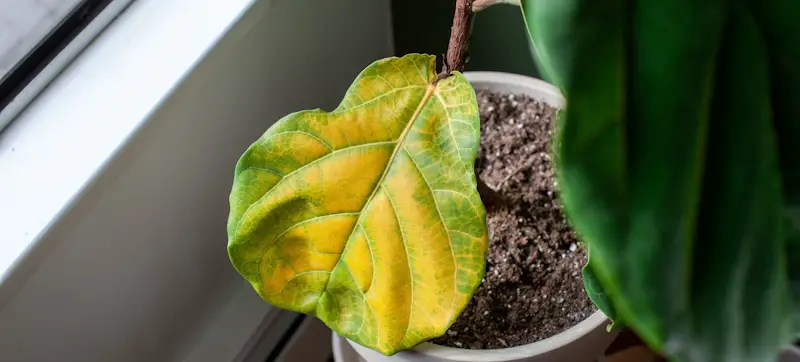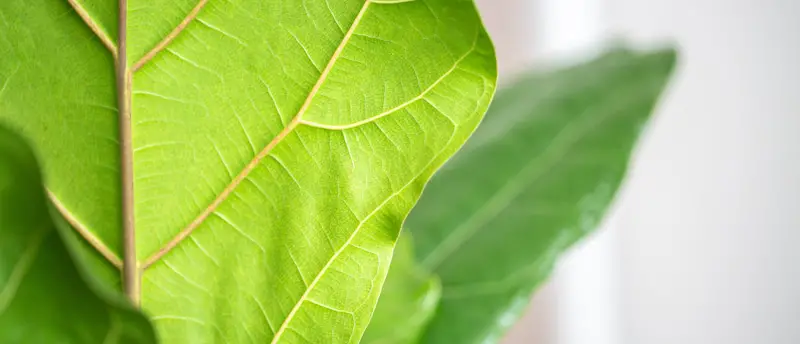Is your fiddle leaf fig experiencing the root rot issue? Don’t panic because it is a common issue with indoor plants, especially the fiddle leaf figs. However, root rot can be a severe problem if not well managed; so, what is root rot fiddle leaf fig, and how do you treat it?
Root rot in fiddle leaf figs is a disease that causes the root rotting, browning, and shedding of the leaves. Overwatering, poor drainage, and bacterial or fungal infections cause root rot. Fix the overwatering or drainage problems with hydrogen peroxide solution or root supplements.
If left untreated, root rot in fiddle leaf figs can cause disease and death in days or weeks. So, how can you tell if your fiddle leaf figs have root rot, and what should you do to get them back to good health? Find out the answers and much more in this post.
What Is Root Rot In Fiddle Leaf Fig?
Root rot in fiddle leaf fig is a disease that causes rotting and decomposing of the leaves. It usually occurs because of overwatering or lack of proper drainage. Excess water in the soil prevents oxygen from reaching your plant’s roots. This causes the rotting to creep to the rest of your plant, like the stem and the leaves.
Other causes of root rot in the fiddle leaf fig are bacterial or fungal infection. The fungi in the soil develop due to excess moisture. Note that bacterial organisms naturally inhabit the soil. Therefore, when you overwater the ground, you give the bacteria room to thrive and affect your plant.
Other causes of root rot in fiddle leaf figs are; using the wrong soil mix that retains too much water or using an impenetrable pot. Root rot usually starts as a mild disease but can kill your fiddle leaf fig within days or a few weeks. If left untreated, it can also spread to other plants on the same ground.
What Are The Signs Of Root Rot Fiddle Leaf Fig?
Most plant owners do not know if their plants have root rot because the issue usually starts under the soil. Therefore, you cannot physically see the rotting roots. However, you can watch out for the following signs of root rot in fiddle leaf figs.
Browning Of The Leaves
One of the top signs of root rot in fiddle leaf figs is the browning of the leaves. The leaves turn medium brown, dark brown, or black from the base, center, or tips. However, this sign could also indicate pest infestation, drought, or bacterial infection. Looking for other symptoms is the best way to ensure the right diagnosis.
Mushy And Dark Roots
The surest way to diagnose root rot in fiddle leaf figs is by uprooting them and checking their roots. Fiddle leaf fig infected roots are usually dark and mushy. They also feel wet because of the excess moisture.
Drooping Of The Leaves
Root rot in fiddle leaf figs causes drooping of the leaves. The excess water suffocates the plant and prevents it from drawing in oxygen, water, and essential nutrients from the soil. The lack of these crucial elements makes the leaves droop and turn yellow.
Unpleasant Smell And Algae
Rotten roots have a distinct decaying smell. Therefore, if your plant has rotten roots, you may notice an unpleasant smell in the soil or around it. Another sign of root rot is algae or mold around the base of your fiddle plant. Algae usually thrive in moist environments.
Healthy Fiddle Leaf Fig Roots vs. Root Rot: Know the Differences
If you suspect that your fiddle leaf fig suffers from root rot, you should first unpot it and inspect its roots. Don’t base your diagnosis on symptoms like browning or yellowing of the leaves only because these can be signs of other diseases and pathogenic infections. The surest way to diagnose root rot is from the roots. Know the differences between healthy and rotten roots; here are some differentiating elements.
- Appearance: Healthy fiddle leaf figs roots are usually white and crispy, while rotten roots are brown and mushy.
- Smell: Healthy fiddle leaf figs roots do not have a specific odor. On the other hand, unhealthy roots have a distinct musty smell.
- Feel: Healthy fiddle leaf fig roots usually feel firm. However, rotten roots feel soft and slimy to touch.
How To Treat Root Rot Fiddle Leaf Fig
After assessing your fiddle leaf fig roots and confirming that root rot is the problem, start addressing the issue. Below is a guide for treating root rot in fiddle leaf figs.
Step 1: Prune The Damaged Roots And Leaves
Use a sterilized sharp pair of scissors to prune the rotten leaves. Handle the pruning with caution and make clean cuts. Also, do not neglect any root, even ones with the slightest sign of root rot. Do the same with affected leaves but only remove a few leaves to avoid interfering with the plant’s photosynthesis.
Step 2: Spray The Roots With Hydrogen Peroxide Solution
You should know that even the healthy leaves will retain root rot fungi and microorganisms even after pruning the damaged leaves. Hydrogen Peroxide solution will kill off the root rot-causing organisms.
Step 3: Repot The Plant
Finally, repot your fiddle leaf fig in a new container filled with fast-draining soil. You can add some gravel or foam block at the bottom to improve the drainage and prevent recurring issues. Afterward, water it once and give it time to drain out before doing it again.
Step 4: Apply Root Supplements
Applying root supplements will help your plant retain its health faster. It will also help the roots grow back quicker.
How To Care For Fiddle Leaf Fig?
After treating the root rot, your plant would benefit from proper care. Below are some tips for caring for your fiddle leaf fig after root rot.
- Do not overwater the plant.
- Use a moisture meter to check the moisture levels at the bottom of your plant to prevent overwatering.
- Ensure to pot the plant in well-draining soil.
- Do not use fertilizers on your fiddle leaf figs. Give it some time to recover before applying fertilizers again.
- Ensure to keep it at ideal temperature levels to allow it to recover from the disease. Fiddle leaf figs thrive in temperatures around 60 to 750F.
FAQs On Root Rot In Fiddle Leaf Fig
Root rot is a common issue with fiddle leaf figs and other houseplants. Below are commonly asked questions about root rot in fiddle leaf figs and their answers.
Can A Fiddle Leaf Fig Recover From Root Rot?
If you notice the disease early and treat it accordingly, your plant can recover and continue thriving. After-care practices like not overwatering and using well-draining soil will enhance recovery. Sadly, if left untreated, the disease will eventually kill your plant.
How Can You Tell If A Fiddle Leaf Fig Has Root Rot?
You can identify root rot in fiddle leaf figs through the following signs;
- Musty-smelling roots or soil.
- Dark, soft, and mushy roots.
- Yellowing or browning of the leaves.
- Browning of the stem.
- Drooping of the leaves and stem.
- Mold at the plant base.
How Can You Prevent Root Rot In Fiddle Leaf Figs?
You can prevent root rot by keeping your plant in a bright spot where it gets at least 6-8 hours of light daily. Planting your fiddle leaf fig in well-draining soil, not overwatering, and repotting it every year will keep it in optimum health.
Conclusion
Root rot fiddle leaf figs is a serious condition that can cause your plant’s death. It stems from excess water in the soil, which cuts off the plant’s oxygen, water, and nutrient supply. Root rot affects the roots and slowly spreads to the stem and branches. However, you can treat the root rot by pruning the affected roots, applying hydrogen peroxide solution, and repotting it in well-draining soil. Try out the treatment and care tips, and share the results!
More like this: Are Fiddle Leaf Figs Toxic to Dogs & Cats?
Victoria is the owner and main author of hobby plants. She loves spending her free time in her garden planting and taking care of her plants. Victoria hopes you enjoy the content here!


![How Often to Water Fiddle Leaf Fig? [COMPLETE GUIDE] How Often to Water Fiddle Leaf Fig? [COMPLETE GUIDE]](https://www.hobbyplants.com/wp-content/uploads/2022/06/how-often-to-water-fiddle-leaf-fig-300x158.jpg)
![How to Propagate Fiddle Leaf Fig [BEST METHODS] How to Propagate Fiddle Leaf Fig [BEST METHODS]](https://www.hobbyplants.com/wp-content/uploads/2022/06/how-to-propagate-fiddle-leaf-fig-300x158.jpg)
![Why Is My Fiddle Leaf Fig Dropping Leaves? [ANSWERED] Why Is My Fiddle Leaf Fig Dropping Leaves? [ANSWERED]](https://www.hobbyplants.com/wp-content/uploads/2022/06/why-is-my-fiddle-leaf-fig-dropping-leaves-300x158.jpg)
![How to Repot a Fiddle Leaf Fig [COMPLETE GUIDE] How to Repot a Fiddle Leaf Fig [COMPLETE GUIDE]](https://www.hobbyplants.com/wp-content/uploads/2022/06/how-to-repot-a-fiddle-leaf-fig-300x158.jpg)
![Fiddle Leaf Fig Outdoors - Can They Survive? [ANSWERED] Fiddle Leaf Fig Outdoors - Can They Survive? [ANSWERED]](https://www.hobbyplants.com/wp-content/uploads/2022/07/fiddle-leaf-fig-outdoors-300x158.jpg)
![Are Fiddle Leaf Figs Toxic to Dogs & Cats? [ANSWERED] Are Fiddle Leaf Figs Toxic to Dogs & Cats? [ANSWERED]](https://www.hobbyplants.com/wp-content/uploads/2022/07/are-fiddle-leaf-figs-toxic-to-dogs-300x158.jpg)